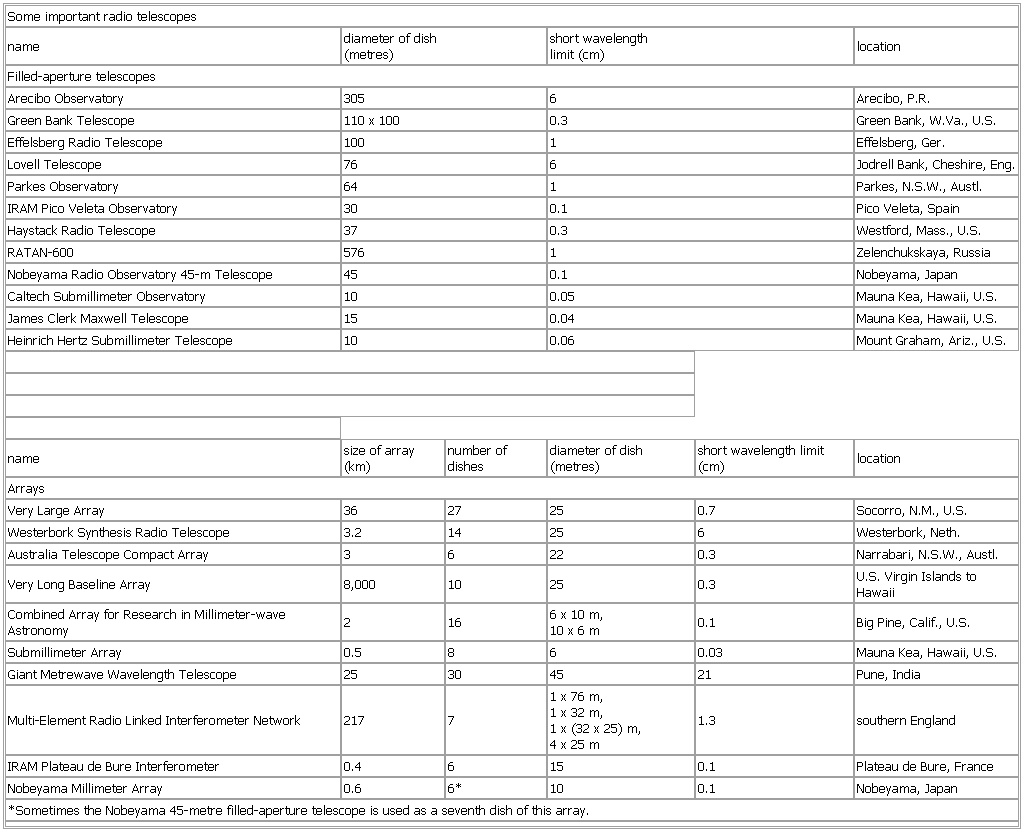- Some important radio telescopes
-
▪ TableSome important radio telescopesname diameter of dish(metres) short wavelengthlimit (cm) locationFilled-aperture telescopesArecibo Observatory 305 6 Arecibo, P.R.Green Bank Telescope 110 x 100 0.3 Green Bank, W.Va., U.S.Effelsberg Radio Telescope 100 1 Effelsberg, Ger.Lovell Telescope 76 6 Jodrell Bank, Cheshire, Eng.Parkes Observatory 64 1 Parkes, N.S.W., Austl.IRAM Pico Veleta Observatory 30 0.1 Pico Veleta, SpainHaystack Radio Telescope 37 0.3 Westford, Mass., U.S.RATAN-600 576 1 Zelenchukskaya, RussiaNobeyama Radio Observatory 45-m Telescope 45 0.1 Nobeyama, JapanCaltech Submillimeter Observatory 10 0.05 Mauna Kea, Hawaii, U.S.James Clerk Maxwell Telescope 15 0.04 Mauna Kea, Hawaii, U.S.Heinrich Hertz Submillimeter Telescope 10 0.06 Mount Graham, Ariz., U.S.name size of array (km) number of dishes diameter of dish (metres) short wavelength limit (cm) locationArraysVery Large Array 36 27 25 0.7 Socorro, N.M., U.S.Westerbork Synthesis Radio Telescope 3.2 14 25 6 Westerbork, Neth.Australia Telescope Compact Array 3 6 22 0.3 Narrabari, N.S.W., Austl.Very Long Baseline Array 8,000 10 25 0.3 U.S. Virgin Islands to HawaiiCombined Array for Research in Millimeter-wave Astronomy 2 16 6 x 10 m,10 x 6 m 0.1 Big Pine, Calif., U.S.Submillimeter Array 0.5 8 6 0.03 Mauna Kea, Hawaii, U.S.Giant Metrewave Wavelength Telescope 25 30 45 21 Pune, IndiaMulti-Element Radio Linked Interferometer Network 217 7 1 x 76 m,1 x 32 m,1 x (32 x 25) m,4 x 25 m 1.3 southern EnglandIRAM Plateau de Bure Interferometer 0.4 6 15 0.1 Plateau de Bure, FranceNobeyama Millimeter Array 0.6 6* 10 0.1 Nobeyama, Japan*Sometimes the Nobeyama 45-metre filled-aperture telescope is used as a seventh dish of this array.See as table:

* * *
Universalium. 2010.
